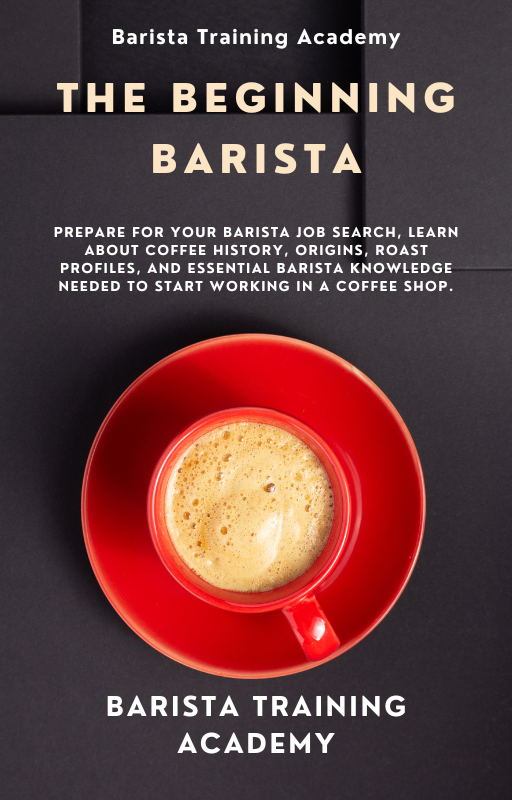Barista Training Answers
Barista Training: Test Your Barista Knowledge
Quiz 2 – barista Training Answers
1. Espresso is…
c. a brewing method of extracting coffee under high pressure
Although today espresso is a synonym to the most popular coffee drink, it’s essentially a brewing method. “Espresso” means “quick” in Italian, and this is because the first espresso machines appeared in Italy and brewed coffee faster than any earlier devices. If you want to know more about the history of the term “espresso” and espresso machines, read the article here.
2. To steam milk for a 6oz cappuccino, you use…
a. 12oz pitcher filled ⅓ full
A good barista doesn’t waste coffee or milk. That’s why you should use the smallest pitcher to steam a certain amount of milk. For a regular 6oz cappuccino, you can use the smallest pitcher and fill it with approximately 4oz of cold milk. Never fill your pitcher more than half full because when you steam the milk, it will expand 30-40%. Learn how to take your milk steaming technique to a new level here.
3. Coffee contains plenty of these substances, which can lower the risk of diseases.
c. Antioxidants
American Cancer Association has conducted research and concluded that coffee is a great source of antioxidants, which means it can reduce the growth of cancer cells and inflammatory processes and prevent from developing any chronic diseases. Read more about coffee benefits here.
Barista Training Answers Continued
4. In manual coffee brewing, the best coffee to water ratio is…
b. 60 g of coffee per 1 liter of water
Specialty Coffee Association of America came with a golden ratio of 18 g of water to 1 g of coffee. It means that the ideal coffee to water ratio is 60 g of coffee per 1 liter of water. Read more about manual coffee brewing techniques here.
5. Dark roasted coffee is…
a. oily on the surface and tastes ashy
As you roast coffee beans, you burn caffeine out of them. While roasting, various chemical reactions start to occur in coffee beans. The sugars start to caramelize, the water evaporates, and oils concentrate and come out on the surface. Learn how to distinguish different coffee roasts here.
6. What coffee drink comprises 1/3 espresso, 1/3 steamed milk, and 1/3 milk foam?
c. Cappuccino
Actually, cappuccino has equal amounts of espresso, steamed milk, and milk foam. It’s a favorite drink of many coffee lovers, often decorated with beautiful latter art designs. This is one of the drinks that is most often ordered in coffee shops along with these.
7. Which one of these is the first milk-steaming stage?
b. Stretching
Stretching or aerating is the first stage of milk steaming, during which you keep the tip of the steam wand close to the surface and add the air to your milk. You will hear a hissing or paper tearing sound. Aerate your milk until 100F. Then proceed to the heating or incorporating stage. Master your milk steaming skills with our selected barista tips here.
8. What is NOT a free-pour latte art design?
c. Spider web
The free pour is the most popular latte art technique. It’s used to create such latte art designs as heart, rosetta, organic flower, and tulip. The customers are always delighted to get a nicely decorated latte art on their drinks. That’s why learning the free-pour techniques is one of the basic things a barista should master. Read more about different latte art designs in our article.
9. How many times is it advised to do a full backflush as part of the cleaning routine in a coffee shop (during the day)?
b. Twice
Usually, every coffee shop runs a full backflush twice a day. Once – in the middle of the day and then at night after the last shift is finished. It’s important to rinse your espresso machine in between full back-flushes. Read more of our coffee shop maintenance tips here.
10. Typically, the extraction time for a double espresso shot (18 g of ground coffee) takes…
c. 20-30 seconds
A typical double espresso shot should take 20-30 seconds to brew if the ground and tamped correctly. A shot that takes less than 20 seconds to extract will most probably be over-extracted. A shot that takes more than 30 seconds to extract will most probably be under-extracted. Learn more about espresso fundamentals here.

Brought to you by Barista Training Academy, “The Beginning Barista,” Your Ultimate Prep Guide to Getting Your First Job as a Barista” is an ultimate resource that is available online. It is affordable for anybody who is looking to start a career in the coffee industry. For more information, visit our blog.
